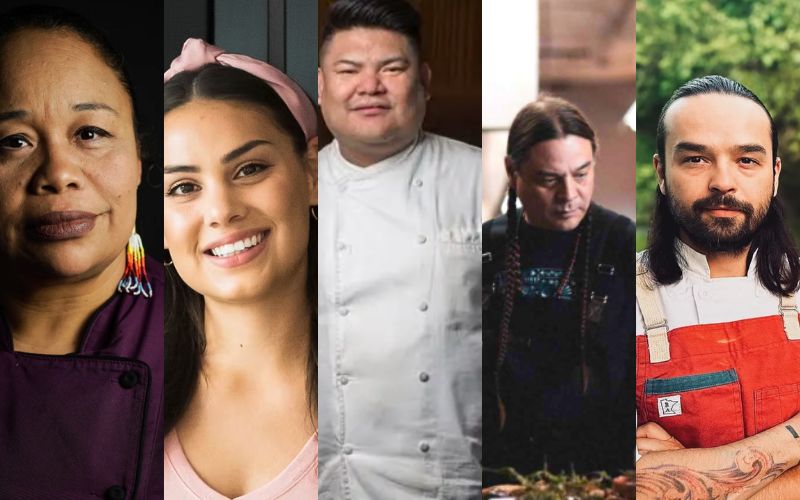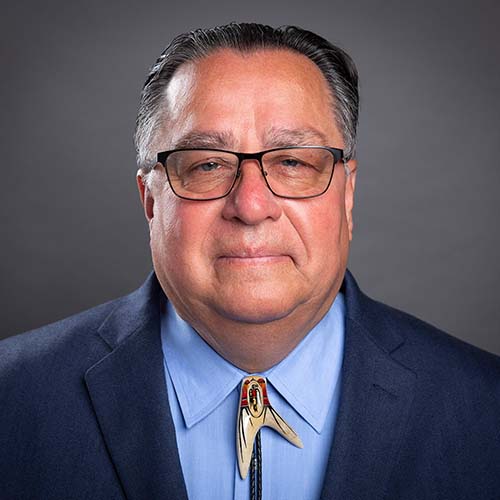
- Details
- By Elyse Wild
The traditional practices and values of tribes across Indian Country are as varied as they are numbered, but there is one thing they all have in common: food is a centerpiece of culture.
As the food sovereignty movement swells in Indian Country, Native American chefs are bringing traditional and contemporary Indigenous foods to home kitchens and acclaimed restaurants across the U.S.
From James Beard Award winners to "Chopped" frontrunners, these Native American chefs are elevating Indigenous foodways in their communities and on the national stage.
Here are five Native American chefs you should know.
Crystal Wahpepah (Kickapoo Nation of Oklahoma)
Kickapoo Nation Chef Crystal Wahpepah burst onto the food scene in 2016 when she became the first Indigenous contestant on the Food Network's wildly popular food competition show "Chopped." Born and raised in Oakland, California, on Ohlone land, Wahpepah's love of food began as a child, making meals with her grandmother and aunties.
Today, she brings that same sense of community to her restaurant, Wahpepah's Kitchen. With a menu bursting with ingredients sourced from Indigenous farmers — wild rice, hibiscus, blue corn, mushrooms, and more — the restaurant serves dishes that blend land acknowledgement with food sovereignty.
"I feel this is the human right for everybody to have their own cultural foods and to eat it and to have that relationship with it on their homeland … or even not on their homeland," Wahpepah told KQED in 2024.
Stephanie "Pyet" DeSpain (Prairie Band Potawatomi Nation)
Chef Stephanie "Pyet" DeSpain honors her cultural heritage, Native American and Mexican, through food. DeSpain grew up between the Osage Indian Reservation and Kansas City, where she spent her childhood in her family's taquerias.
In 2015, she launched a culinary business to promote whole foods made with Indigenous flavors. A year later, she drew national acclaim as the first winner of Gordon Ramsay's Next Level Chef. Her cookbook, Rooted in Fire, tells the stories behind Native ingredients with contemporary recipes that celebrate her cultural roots shared by many across Indian Country.
Freddie J. Bitsoie (Diné)
For Chef Freddie J. Bitsoie (Diné), the notion of Native American cuisine is a misnomer. Instead, the award-winning chef emphasizes looking at Native foods through regionally unique ingredients and techniques.
"We must start looking at it from a more regional aspect... When discussing Indigenous foods, the foods that shape a specific region are hyper-local," the award-winning chef said during a visit to Penn State in 2023. "The best way I have found to tell our history is through the culinary arts because that's what I'm working to rediscover."
From 2016 to 2020, Bitsoie was the executive chef at the Mitsitam Native Foods Café at the National Museum of the American Indian. His 2022 cookbook, the New Native Kitchen: Celebrating Modern Recipes of the American Indian, features 100 recipes that use modern techniques and sensibilities to enrich traditional Native recipes from regions across Indian Country.
Sean Sherman (Oglala Lakota Sioux)
Known by the moniker "The Sioux Chef," James Beard award winner Sean Sherman may be the most celebrated Native American chef of our time. Sherman grew up on the Pine Ridge Reservation and later cooked at restaurants in South Dakota during the early days of the farm-to-table movement. After a revelation that there were no Native American restaurants in the United States, he began his life's mission to reawaken Native American cooking techniques using Indigenous ingredients — all while addressing the extreme health disparities caused by colonial diets forced on Native peoples.
In 2021, Sherman opened Owamni, a full-service restaurant serving only pre-colonial ingredients in downtown Minneapolis. Along with netting a coveted James Beard award for his first cookbook, Sherman has been honored with Julia Child Award and was named one of Time Magazine's 100 Most Influential People of 2023.
Chef Bryce Stevenson (Red Cliff Band of Lake Superior Chippewa)
From 2023-2024, James Beard nominee Chef Bryce Stevenson's restaurant Miijim centered traditional Ojibwe foods with a dash of French technique. The menu featured venison and rabbit, freshwater fish, and wild foods like manoomin, sumac, cedar spruce tips, and maple.
While Stevenson temporarily closed the Madeline Island eatery due to infrastructure challenges, he is on the hunt for a new location to reopen its doors. In the meantime, Stevenson heads up the kitchen at Wisconsin's critically acclaimed small plate restaurant Odd Duck. He continues to bring Ojibwe cuisine to Milwaukee's food scene with highly-anticipated fusion pop-ups, most recently an Ojibwe-Korean collaboration dinner with Korean chef Jenny Lee.
More Stories Like This
Zuni Youth Enrichment Project and Partners at Ho’n A:wan Productions Launch 8th Annual Delapna:we ProjectChickasaw Holiday Art Market Returns to Sulphur on Dec. 6
Center for Native Futures Hosts Third Mound Summit on Contemporary Native Arts
Filmmakers Defend ‘You’re No Indian’ After Demand to Halt Screenings
A Native American Heritage Month Playlist You Can Listen to All Year Long
Help us defend tribal sovereignty.
At Native News Online, our mission is rooted in telling the stories that strengthen sovereignty and uplift Indigenous voices — not just at year’s end, but every single day.
Because of your generosity last year, we were able to keep our reporters on the ground in tribal communities, at national gatherings and in the halls of Congress — covering the issues that matter most to Indian Country: sovereignty, culture, education, health and economic opportunity.
That support sustained us through a tough year in 2025. Now, as we look to the year ahead, we need your help right now to ensure warrior journalism remains strong — reporting that defends tribal sovereignty, amplifies Native truth, and holds power accountable.
 The stakes couldn't be higher. Your support keeps Native voices heard, Native stories told and Native sovereignty defended.
The stakes couldn't be higher. Your support keeps Native voices heard, Native stories told and Native sovereignty defended.
Stand with Warrior Journalism today.
Levi Rickert (Potawatomi), Editor & Publisher


